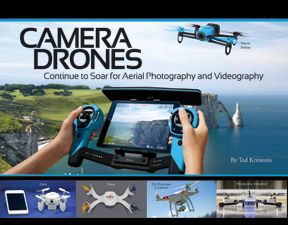
Taking a selfie may be par for the course for today’s snapshooters, but shooting oneself from the air is something altogether different. Drones are still fairly expensive but have dropped in price enough to make them affordable to most consumers, and that means aerial photography and videography is within reach.
Aerial vantage points used to be off limits to most, especially hobbyists and professionals who lacked the resources to get up in the air at a moment’s notice. With the level of choices available now, those days appear to be over. However, the legalities of using small, unmanned drones for commercial purposes falls under the purview of the Federal Aviation Administration (FAA).
The popularity of drones has been such that everyone from Realtors and farmers to Hollywood filmmakers has become just as interested in utilizing them for their respective reasons. Even Amazon wants to eventually use drones for delivering smaller packages to customers. Since small drones are considered small aircraft under FAA rules, Congress has asked the agency to propose regulations on a wider commercial use of drones weighing less than 55 pounds. Despite a fall 2015 deadline, it seems unlikely anything will be finalized by then.
That makes parameters around current usage a little murky. Hobby or recreational flying doesn’t require FAA approval, but flying for commercial purposes is against the agency’s regulations. A permit system has been set up to streamline that process, though it’s unclear how pervasive it’s been outside of the film industry. Under the FAA limits, it would technically be against the rules to shoot a video from a camera attached to a drone and then sell it. However, if that video was clipped with other footage in a final edit, say for a wedding or real estate production, there would be no problem.
Those scenarios and the wide availability of drones mean it’s largely a gray area until regulations are finalized. Manufacturers aren’t waiting to see, either. The potential of the drone industry is significant if projections are accurate. The Association for Unmanned Vehicle Systems International (AUVSI) forecasts economic activity totaling $82.1 billion and 100,000 high-paying jobs—all between 2015 and 2025.
Drone options are growing in both abundance and quality, and their sophistication is matched by more user-friendly operation and improved battery life. Here is a selection of today’s “highest flying” drones.
DJI Phantom 2 Vision+
Chinese manufacturer DJI hasn’t been shy in positioning this drone as an aerial photography and videography tool for cinematographers and consumers alike. And its feature set seems designed for just such a purpose. The longer Wi-Fi range of 2,300 feet raises the possibility of the drone drifting out of range or sight in higher winds, though the more durable body and stabilizers allow it to keep steady in up to 25mph gusts. When it does veer beyond range, three-axis image stabilization handles pitch, roll and yaw. Plus, once it exceeds the control range of the remote control, a “return-to-home” function triggers, enabling the drone to automatically fly back to its takeoff point and land safely.
The Phantom 2 Vision+ boasts an upgraded 14 megapixel camera that can capture still images and 1080p Full HD video at 30 frames per sec, or 720p HD at 60 fps, as well as the option of slow motion video. The camera has a 90º tilt to enable shooting at any angle along that range, including straight ahead or straight down. Its integrated GPS does open things up to set routes but has an equally important job in helping stabilize the drone in the air. A firmware update to that will also block the drone from venturing near airports or no-fly zones.
Footage is saved to the 4GB microSD card that comes with the drone, though previewing and framing shots in real-time is done via the free DJI Vision mobile app on a smartphone or tablet. The app is also used to adjust settings. Also in the box is a remote controller that includes a holder for a smartphone, since it doesn’t have a screen of its own to preview footage. Battery life is currently rated at 25 minutes of flight time, and two batteries are included, so having one as a backup should double that in one outing. MSRP: $1,369. dji.com
Parrot Bebop
Parrot has been instrumental in making drones accessible and fun to consumers, yet the Bebop stands out because it’s the most expensive and extensive quadcopter the company has produced. Smaller in stature than the A.R.Drone 2.0, the Bebop has a lightweight body and softer rotors that are programmed to stop spinning on impact with a solid object. Bumpers along the sides have been included to protect the rotors and withstand pressure from higher winds.
Also, unlike previous Parrot drones, this one has a 14MP camera capable of capturing Full HD 1080p video at 30 fps, with a three-axis stabilizing system. The camera doesn’t have full range flexibility because there’s no gimbal, but Parrot says it can pan and zoom 180º digitally without affecting the Bebop’s movement. The fisheye effect seen in many action cameras, including the company’s previous drones, has been removed to take away any barrel distortion when shooting photos or recording clips.
It has 8GB of internal storage but no memory card slot to expand on that. Battery life is also limited at just 11 minutes of flight on one charge, but Parrot includes a second battery in the box to help stretch that further.
The Skycontroller is a separate accessory outfitted with hard controls that runs on the Android version of Parrot’s FreeFlight 3 app. External devices, including the Oculus Rift virtual reality headset, can be plugged in via the HDMI port. The device sports amplified antennas and Wi-Fi to fly up to another 1.2 miles. $499.99; $899.99 with Skycontroller. parrot.com/usa
PlexiDrone DreamQii
A promising drone that has gone well beyond its crowdfunding goal on IndieGoGo, the DreamQii PlexiDrone has a fairly small form factor and a mounted camera on a 360º gimbal that can shoot at any angle. However, there is no built-in camera, opening up the option to mount a GoPro or other camera to capture stills and video. Weight restrictions are liberal, to the point where even a mirrorless interchangeable-lens camera will stay in place.
Built-in obstacle avoidance up to 32 feet away makes the drone smart enough not to crash, though the best feature may be “follow me,” which uses the GPS data on a connected smartphone or tablet to stay locked onto the pilot. This would open up the chance to shoot footage of any activity from sports to driving. In addition, swarming capability unites multiple drones together to shoot a subject from different angles and viewpoints.
The DreamQii is slated for launch in March 2015 and will come in a few different configurations that include extras like a GoPro mount and PlexiPack protective case to carry the drone around. MSRPs begin at $699.99 for the PlexiDrone starter kit. plexidrone.com
Zano
Born of a Kickstarter campaign, the Zano is being marketed as “taking your selfies to new heights.” Small enough to fit in the palm of a hand, the Zano derives part of its name from the fact that it’s considered more of a nano drone. Similar to the PlexiDrone, there is a “following” feature tethered to the paired smartphone over Wi-Fi. This also includes obstacle avoidance, though the connected range only tops out at 100 feet.
The onboard camera is capable of only 5MP photos and 720p HD video, though the specs suggest 1080p is entirely possible through a future update. The Zano is scheduled to ship in July 2015. $259.99. flyzano.com
Nixie
Although Nixie is still in development, with no scheduled release date, we thought it warranted a mention here. The winner of Intel’s Make It Wearable Challenge, Nixie is touted as a wearable camera that flies and takes selfies. It had its first public demo at the 2015 CES in January. Cofounders of Nixie, CEO Christoph Kohstall and COO Jelena Jovanovic, shared the stage with Brian Krzanich, Intel’s CEO, for the Intel keynote. With a gesture from Kohstall, Nixie took flight from his hand, shot a photo of him with Krzanich and Jovanovic, and returned.
Nixie is unique because there’s no remote, instead it operates in “boomerang” mode with sensors that give it awareness of space. The drone starts out as a bracelet but unfolds to become a small quadcopter after the user performs a flick of the wrist, which sends the drone in the direction the user wants a photo taken. It flies away, turns around and captures that image “without interrupting the moment.” Those interested can sign up for updates at flynixie.com.





